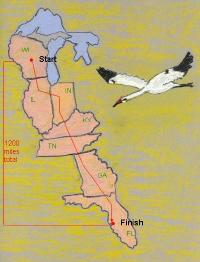 |
 |
October
29, 2004
Migration Day 20
Warm
Temps and Headwinds Prevent Progress
 |
It's
65 degrees F. in LaSalle County, IL this morning. Winds from the
south are blowing at 15 mph. For the fifth day in
a row, the weather is against the migration taking off from this
site. Colder
temps are best for migration. Joe Duff explains:
"Cooler air is more dense than warmer air. Warm air can actually
hold more moisture because there's more room for moisture. When air
is dense and compact (when it's cold) it's thicker, so when you breathe
in you get more oxygen. When you do a wingbeat there's more to push
against. When the propeller spins there's more thrust. When the wing
flies there's more lift to it. The aircraft works better, the engine
works better, the propeller works better, the wing works better. And
for the birds, their wings work better; they get more oxygen and it's
easier to cool their bodies. They don't overheat.
"It's just a lot easier to fly in cold air. That's really a big
factor in their endurance. Warm air just wears
them out very quickly. You see them panting quickly. Their tongues
come out. They start to splay their feet to help cool their bodies,
and they just can't fly."
-
Describe in your journal why cooler temps make better migration conditions for both birds and ultralights.
-
Look at the migration route map. Through how many states will the Whooping cranes pass? How many of these states have you been in? Look at a detailed map of these states and see if you can guess what cities and landforms the cranes will see from above. Why do you think they migrate south into Illinois and then east across to Indiana, rather than taking a straighter, shorter line to Indiana? (Hint: What is the biggest city in any of these states? How might flying over a huge city be a problem?)
Journey North is pleased to feature this educational
adventure made possible by the
Whooping Crane Eastern Partnership (WCEP).
Copyright
2004 Journey North. All Rights Reserved.
Please send all questions, comments, and suggestions to our feedback form